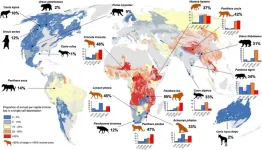(Press-News.org) MINNEAPOLIS/ST. PAUL (02/24/2023) — Published in JAMA, a University of Minnesota led study shows that verapamil, a drug commonly used to treat high blood pressure and heart conditions, can have a beneficial effect on the pancreas in children with newly-diagnosed type 1 diabetes (T1D).
Results of the CLVer clinical trial showed that oral verapamil taken once a day improved the pancreas' insulin secretion by 30% over the first year following diagnosis of T1D when compared with a control group that received a placebo.
“The beneficial effect of verapamil observed in the trial is extremely exciting,” said Antoinette Moran, MD, the study’s principal investigator and professor at the University of Minnesota Medical School. “Although we don’t know whether the beneficial effect of verapamil on insulin secretion by the pancreas will be sustained once treatment was stopped at 12 months, we do know that better pancreas function in the first year is associated with better long-term outcomes in type 1 diabetes.”
The University of Minnesota was one of six pediatric diabetes centers in the U.S. that participated in the study. The trial included 88 children 8 to 17 years old who started the trial within 31 days of their T1D diagnosis. Participants were monitored for known side effects of verapamil, including effects on the heart, blood pressure and liver function. The study found that verapamil was well tolerated and very few of these side effects occurred.
In addition to evaluating verapamil, the trial also assessed whether an intensive glucose management approach that included use of an automated insulin delivery system to try to get glucose levels as close to normal as possible could have a beneficial effect on the pancreas’ insulin secretion. As reported in a companion paper in JAMA, much better glucose levels were achieved with this approach compared with standard care that included use of continuous glucose monitoring; however, a benefit on the pancreas was not observed. Nevertheless, the glucose levels achieved could have long-term benefits in reducing complications of diabetes.
“The fact that verapamil is low cost and readily available, is taken orally once a day, and has a very favorable safety profile makes it a very appealing treatment for children and adults who are diagnosed to have type 1 diabetes” said Dr. Moran.
Funding was provided by JDRF, while Dexcom, Medtronic, and Tandem Diabetes Care provided devices and supplies used in the study.
###
About the University of Minnesota Medical School
The University of Minnesota Medical School is at the forefront of learning and discovery, transforming medical care and educating the next generation of physicians. Our graduates and faculty produce high-impact biomedical research and advance the practice of medicine. We acknowledge that the U of M Medical School, both the Twin Cities campus and Duluth campus, is located on traditional, ancestral and contemporary lands of the Dakota and the Ojibwe, and scores of other Indigenous people, and we affirm our commitment to tribal communities and their sovereignty as we seek to improve and strengthen our relations with tribal nations. For more information about the U of M Medical School, please visit med.umn.edu.
For media requests, please contact:
Alex Smith, Media Relations Specialist at the University of Minnesota Medical School
a-smith@umn.edu
END
Research brief: Verapamil shows beneficial effect on the pancreas in children with newly-diagnosed type 1 diabetes
2023-02-24
ELSE PRESS RELEASES FROM THIS DATE:
A simpler way to track the spread of infectious diseases
2023-02-24
How society organizes affects different phenomena, from the transmission of information to the spread of contagious diseases. The more links we establish with each other via social and transportation networks, the more spread is favored. To study the dynamics of complex systems, such as society, we can infer these networks – in which nodes, representing individuals, connect through lines – from real-world data. However, these networks are usually large, dense, and cumbersome to manipulate.
In previous work, Luís M. Rocha’s group at the Instituto Gulbenkian de Ciência (IGC) found a way to simplify networks ...
Deadly waves: Researchers document evolution of plague over hundreds of years in medieval Denmark
2023-02-24
Attention editors: Under embargo by the journal Current Biology until Friday, February 24 at 11 a.m. eastern
Scientists who study the origins and evolution of the plague have examined hundreds of ancient human teeth from Denmark, seeking to address longstanding questions about its arrival, persistence and spread within Scandinavia.
In the first longitudinal study of its kind, focusing on a single region for 800 years (between 1000-1800AD), researchers reconstructed Yersinia pestis genomes, the bacterium responsible for the plague, and showed that it was reintroduced into the Danish population from other parts of Europe again and again, perhaps via ...
Current air pollution standards tied to higher heart risks
2023-02-24
OAKLAND, Calif. — Long-term exposure to air pollution is tied to an increased risk of having a heart attack or dying from heart disease — with the greatest harms impacting under-resourced communities, new Kaiser Permanente research shows.
The study, published February 24 in JAMA Network Open, is one of the largest to date to look at the effects of long-term exposure to fine particle air pollution, which is emitted from sources such as vehicles, smokestacks, and fires. Fine particle air pollution, also known as PM2.5, are fine particles that are 2.5 micrometers in diameter or smaller. The ...
Comparing transmission of COVID-19 in nightlife, household, health care settings
2023-02-24
About The Study: In this case series study that analyzed 44,000 confirmed COVID-19 cases in Tokyo, cases identified in nightlife settings were associated with a higher likelihood of spreading COVID-19 than household and health care cases. Surveillance and interventions targeting nightlife settings should be prioritized to disrupt COVID-19 transmission, especially in the early stage of an epidemic.
Authors: Michihiko Yoshida, Ph.D., of the Minato Public Health Center in Tokyo, is the corresponding author.
To access the embargoed study: Visit our For The Media website at this link https://media.jamanetwork.com/
(doi:10.1001/jamanetworkopen.2023.0589)
Editor’s ...
Association of long-term exposure to particulate air pollution with cardiovascular events
2023-02-24
About The Study: In this study including 3.7 million adults in California, long-term fine particulate air pollution (PM2.5) exposure at moderate concentrations was associated with increased risks of heart attack, ischemic heart disease mortality and cardiovascular disease mortality. The findings add to the evidence that the current regulatory standard is not sufficiently protective.
Authors: Stacey E. Alexeeff, Ph.D., of the Kaiser Permanente Division of Research in Oakland, California, is the corresponding author.
To access ...
Common pregnancy complications may slow development of infant in the womb, study finds
2023-02-24
Gestational diabetes and preeclampsia may be linked to slower biological development in infants, according to a new study led by USC.
The research, published today in JAMA Network Open, found that newborns exposed to these two pregnancy complications were biologically younger than their chronologic gestational age. The infants’ biological or “epigenetic” age is based on molecular markers in their cells.
The results raise intriguing questions about how common pregnancy complications may affect infants and health outcomes later in childhood. Could they create developmental delays? Could some exposures advance biological ...
Developing countries pay the highest price for living with large carnivores
2023-02-24
A team of researchers has highlighted human-wildlife conflict as one of the globe’s most pressing human development and conservation dilemmas.
New research published in Communications Biology looked at 133 countries where 18 large carnivores ranged, and found that a person farming with cattle in developing countries such as Kenya, Uganda or India were up to eight times more economically vulnerable than those living in developed economies such as Sweden, Norway or the U.S.
Duan Biggs from Northern Arizona University’s School of Earth and Sustainability is the senior author of the study. He partnered with organizations throughout the world to conduct ...
Head injuries could be a risk factor for developing brain cancer
2023-02-24
Researchers from the UCL Cancer Institute have provided important molecular understanding of how injury may contribute to the development of a relatively rare but often aggressive form of brain tumour called a glioma.
Previous studies have suggested a possible link between head injury and increased rates of brain tumours, but the evidence is inconclusive. The UCL team have now identified a possible mechanism to explain this link, implicating genetic mutations acting in concert with brain tissue inflammation to change the behaviour of cells, making them more likely to become cancerous. Although this study was largely carried out in mice, it suggests ...
New study reveals biodiversity loss drove ecological collapse after the “Great Dying”
2023-02-24
SAN FRANCISCO, CA (February 24, 2023) — The history of life on Earth has been punctuated by several mass extinctions, the greatest of these being the Permian-Triassic extinction event, also known as the “Great Dying”, which occurred 252 million years ago. While scientists generally agree on its causes, exactly how this mass extinction unfolded—and the ecological collapse that followed—remains a mystery. In a study published today in Current Biology, researchers analyzed marine ecosystems before, during, and after the Great Dying ...
Differences in animal biology can affect cancer drug development
2023-02-24
A small but significant metabolic difference between human and mouse lung tumor cells, has been discovered by Weill Cornell Medicine researchers, explaining a discrepancy in previous study results, and pointing toward new strategies for developing cancer treatments.
The work, published Jan. 30 in Cancer Discovery, focuses on lung adenocarcinoma, a common but often difficult to treat cancer that researchers have long studied in mouse models. However, those models didn’t quite align with human clinical observations in some instances. The new paper shows why; a specific gene mutation has opposite effects on tumor ...



